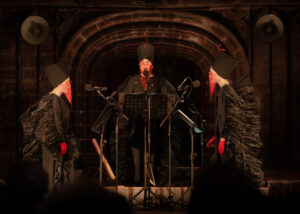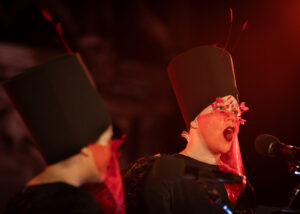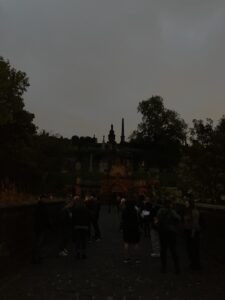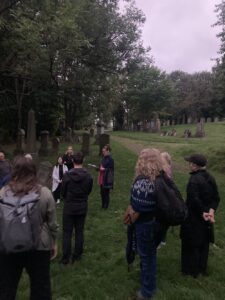Hanna Tuulikki’s latest performance work, writes Blue Kirkhope, places the delicate future of the UK’s red-listed bird species in our hands.
***
I am the bird that never flew
falling awake
in your hands

Photo: Minttu Maari Mäntynen
It is almost a year to the day since British-Finnish multidisciplinary artist Hanna Tuulikki’s Echo in the Dark performance premiered in the grounds of Hospitalfield in Arbroath. Tuulikki continues to create compelling bodies of work that blur the line between human and the more-than-human, and on this occasion, she introduces her new composition the bird that never flew which found a nest within the grandeur of the historic Glasgow Cathedral.
Commissioned by Historic Environment Scotland with Arts&Heritage, the performance echoes the building’s history and that of St Mungo, Patron Saint of Glasgow, who was said to have performed several miracles, including resurrecting a dead robin in his hands. This is commemorated in Glasgow’s coat of arms which depicts a robin perched on top of an oak tree and the words ‘Let Glasgow Flourish’ inscribed beneath its shield. But Tuulikki emphasises that this motto is redundant whilst bird species are facing catastrophic population decline due to the climate emergency. After all, how can a place truly flourish if nature is suffering? Whilst the performance pays tribute to the building’s past, it also draws us to the present and future amongst the four walls of the cathedral’s legacy, and to the reality of the climate catastrophe and severe biodiversity loss that’s happening outside of it.

Photo: Minttu Maari Mäntynen
A slowed down version of a dawn chorus spills from the speakers and into the vast space of the cathedral, inviting the audience themselves to slow down and enter “bird time”. The seats are situated beneath the building’s impressive wooden ceilings and intricately carved stone arches; our “imaginary woodland” for the evening, Tuulikki calls it. One by one, Tuulikki and award-winning Scottish vocalist Mischa Macpherson and Glasgow-based voice and sound artist Lucy Duncombe arrive on stage wearing striking costumes that were designed and made by Tuulikki herself. Tuulikki tells me, ‘The costume is partly inspired by the capercaillie, especially the fanning tail feathers and red eyelids. The red veil is also inspired by the robin redbreast, and by the shape of beaks, as well as a nod to human protest culture by covering the face. The hats and dresses also draw inspiration from Christian ceremonial and monastic clothing. The red gloves are to draw attention to lyrical meaning and have a bird-like claw quality.” The costumes are yet another component of Tuulikki’s work attempting to challenge and eradicate the divide between humans and the more-than-human, this time by physically threading together aspects of the two to become one.
The performance begins with the sound of haunting bird calls infused with distorted electronic drone. The robin is to be our watchful host for the evening, ever-present as it introduces each song dedicated to a UK red-listed woodland species — mistle thrush, capercaillie, nightingale, wood warbler, tree pipit and greenfinch — as well as to the robin itself. Weaving beautifully between bird alarm calls and humansong, the bird that never flew is a desperate cry for us to tune into our environment and to the sound of more-than-human species alerting us to climate catastrophe through political protest. During the song of the greenfinch, the loud high-pitched sound of an ambulance siren appropriately passes by the cathedral, a sound that we as humans instantly recognise as an emergency. As well as conducting the three voices on stage, Tuulikki is also trying to conduct the audience to shift our attention to the alarm calls of bird species in the very same way.
The following morning we are invited on a dawn chorus walk in the Glasgow Necropolis, a Victorian cemetery situated just behind the cathedral. A crowd began to sleepily gather on the bridge for a 6am start, and Tuulikki alerted me to the song of the robin; an apt way to start the day as last night’s performance still lingered in the air. By the time everyone had arrived, the dark veil of the early morning had slowly begun to lift and shadows became light. We were welcomed by poet, artist, performer and academic Camilla Nelson who specialises in exploring the relationship between human and more-than-human through language. Tuulikki began with a song and Nelson read aloud a poem before we began walking and were invited to listen deeply as we made our way through the cemetery. Wrens, goldfinches, black-backed gulls, blackbirds, robins, blue tits and coal tits frequently greet us along the way, as well as the sound of the gravel in the paths crunching underfoot and the noise from the Wellpark Brewery spewing vapour, again alerting us to our proximity to these species and our coexistence with them.

We stop at various points along the way throughout the cemetery and at one point Nelson begins to read out the 70 bird species currently on the UK red list, which has almost doubled since 1996 when the first review took place. Arctic Skua. Spotted flycatcher. Black grouse. Ringed plover. Curlew. The list goes on, and sorrow rises through the group as the sun ascends in the sky. It is not long before we become a collective, encouraged by Nelson to flock together and copy one another’s movements; stopping to listen when someone else does, walking towards another bird call that we are alerted to, mimicking the actions of the very birds we are now attuned to. The morning moved between walking and talking and Tuulikki beautifully sang a selection of solo vocal bird studies, again toing and froing between human and non-human species and blurring the line between us all. The dawn chorus walk was an invitation to put our ecological awareness into practice and to truly listen.

There is a bell which is also illustrated in the Glasgow crest signifying another of St Mungo’s miracles. St Mungo’s bell, which is no longer at the cathedral, used to ring during services to mourn the dead. But in its absence today Tuulikki’s composition continues the bell’s old tradition, grieving both the bird species already lost and those that will be lost during the climate crisis if we do not intervene. Tuulikki’s work is poignant, beautiful, and sadly vital. But it is also full of hope. It is an honourable and difficult responsibility to urge us to reassess our role in a world where we so often other ourselves from the species we share this ecosystem with. the bird that never flew is a call to action, encouraging us to be more ecologically aware. Perhaps our own miracle would be to truly listen and act in order to reverse the damage that has already been done. Much like the story of St Mungo and the robin, the future is in our hands.
*
Blue Kirkhope is a writer, walker and birdwatcher from Glasgow whose work focuses on community, the environment, climate change and nature connectedness. You can follow her on Instagram, Threads or Substack.